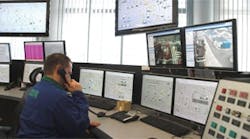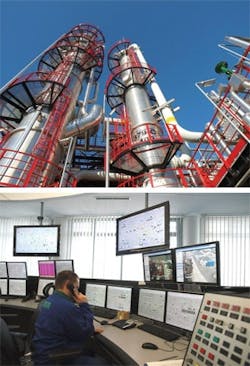Check Out Montague's Google+ profile.
You can't just waltz into a refinery's process control system with mainstream, IT-based computers and expect to be successful.Big process applications are unique environments—even from one to another—so they need the appropriate controls hardware and software deployed in the correct manner to operate safely and efficiently. One size definitely doesn't fit all when it comes to process control.
This isn't to say that the latest software and smart computing devices can't be used in refineries or other process facilities, but they must be adapted to meet the individual performance requirements of each new setting, especially when it comes to safety. Fortunately, many of today's distributed control systems (DCSs) are gaining some improved capabilities, and getting the chance to perform in new applications.
For instance, 47-year-old OOO Kirishinefteorgsintez (OOO Kinef) is northwest Russia's only oil refinery located near Baltic Sea ports. It has a refining capacity of 19.8 million tons per year, and produces 80 refined petroleum products for the Russian Federation and Europe, including unleaded gasoline, diesel fuels, jet fuel, heating oils, bitumen, hydrocarbon liquefied gases, aromatics and solvents, polyalkylbenzene, linear alkyl benzene (LAB), alkylbenzene sulfer acid (ABSA), normal paraffins, sulfuric acid, sulfur and roofing materials.
Also Read: Upgrading Your DCS: Why You Might Need to Do It Sooner Than You Think
To upgrade its process control systems and improve operations and financial performance, OOO Kinef recently implemented Honeywell Process Solutions' Experion Process Knowledge System (PKS) on its gas fractionating unit (GFU) and crude distillation unit (AT-1). Experion PKS serves as the core control platform, and provides basic process control, safeguarding functions, anti-surge control and compressor equipment protection. Also, the refinery has equipped its two process units with Honeywell's specialized Advanced Alarm Manager software to enable early incident detection and response, alarm initiation analysis and task-specific reporting.
OOO Kinef reports the benefits of its new control system include increased reliability and overall performance improvement, maximized equipment utilization, targeted return in investment (ROI) and faster project implementation and interoperability with its existing systems. "When choosing a control system, we wanted to address the primary objective of automating selected process units, as well as related challenges, such anti-surge control, compressor equipment protection and process safety monitoring," says Vadim Somov, OOO Kinef's general director. "In particular, we're using Honeywell's specialized Advanced Alarm Manager platform to help operators prevent incidents."
Complex Jobs, Added Safety
Besides making existing processes more efficient, DCSs are also implemented to help coordinate automation and safety systems in increasingly complex process applications that must comply with new specifications and regulations.
Figure 1: To produce fuels in compliance with EU environmental standards, INA Rijeka oil refinery in Croatia installed integrated control and safety systems in a centralized control room (above) on three units at its hydrocracking complex (top).
Photo Credit: Emerson Process Management and INA Rijeka
The hydrocracking plant's integrated solution consists of Emerson
Process Management's PlantWeb digital plant architecture, including its DeltaV automation system and DeltaV SIS safety instrumented system. In addition, Emerson provided field instrumentation and control valves, and its Asset Management Suite (AMS) predictive maintenance software is used to configure devices on the three process units. Also, Emerson served as main automation contractor (MAC) and point of contact for three engineering, procurement and construction (EPC) firms working on the project. "Emerson was able to deploy its local resources to coordinate these activities, and ensure the integrated system offered a common user interface for all three units," says Igor Šepić, INA Rijeka's refinery director. ""Emerson's project management services helped us start the units up on time and within budget."
In all, the revamped complex incorporates nearly 50 process controllers, 180 logic solvers and approximately 5,000 process and safety I/O points. Following commissioning, INA Rijek reports its operators were able to bring the plant on stream quickly and smoothly because, prior to start-up, they were trained off-line using Emerson's OTS simulator. This enabled them to respond to simulated process upsets in an off-line, no-risk environment prior to actual plant operation.
More Product, Less Variability
Beyond optimizing operating conditions, another persistent problem must be solved as process applications produce ever higher product volumes and varieties—how to reduce variability.
For instance, Glatfelter's 120-year-old Chillicothe mill in Ohio manufactures 400,000 tons of specialty papers per year on four paper-making machines, which are supplied by a timber yard, bleached Kraft pulp mill, eight batch digesters and four boilers, and also work with one coater and a variety of paper converting machines. The largest of the four machines, nicknamed the Chief, was built in 1980, renovated in 2000, and produces a wide range of specialty products.
However, as product mixes diversified, converting equipment evolved and paper chemistry improved, Glatfelter reports that coating buildups increased on its caliper gauges, which caused more measurement errors and more ridging, roping, wrinkles and other quality problems on its paper. "Bad readings create false control actions, which result in low-quality products, internal rejects and ultimately in low-quality yields," says Chad Biddix, Glatfelter's stock preparation superintendent.
To improve its caliper measurements and quality control, Biddix and his colleagues at Glatfelter decided to adopt ABB's Extended Automation System 800xA and two Network Platform NP1200 scanners with optical caliper sensors—one at the size press and the other at the reel. These optical caliper sensors stabilize the sheet on one side, and then make a confocal, non-contact measurement on the other.
Following start-up, the benefits of the new control system and scanners were immediate. Glatfelter reports that internal rejects due to caliper errors or mechanical defects caused by poor caliper control were virtually eliminated, and the time needed to make paper-grade changes was drastically reduced.
"Our controls group and ABB developed an automated paper-grade change process, which allowed us to make paper-grade changes with no losses," explains Randy Dittman, the Chief's superintendent. "Even when making the most challenging of changes, we can now reach the right specification in seven minutes. This means that paper-grade changes have less than a 1% impact on our efficiency. Also, despite all the paper-grade changes the Chief makes, its winder remains one of the most productive in North America. The paper must be perfect before going to the winder, which runs at 8,500 feet per minute. If it runs well on our winder, then we can be confident it will run well on our customers' winders, too."
Likewise, Dittman adds that 800xA controls allow Glatfelter to study the Chief's frequency of disturbances, and apply them to the mill's other machines. "It's allowed us to link changes in performance to process upsets," he explains. "This means we're able to identify and eliminate sources of variation. We can test as much as we want to test. The online, spectral analysis has been a big help with all of this."







